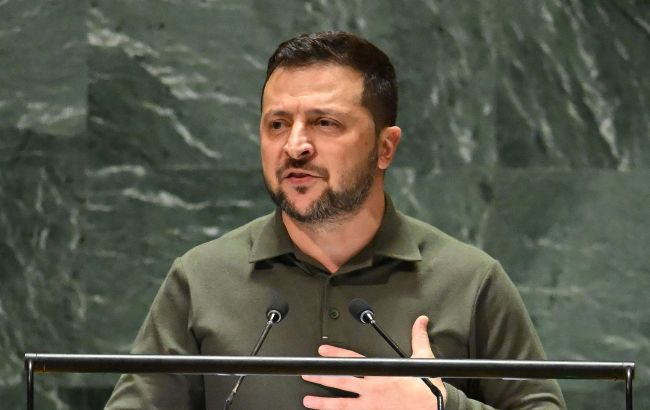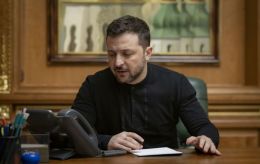Global Peace Summit: What Zelensky's formula is about and which provisions will be discussed
 Photo: Volodymyr Zelenskyy speaking at the UN General Assembly in 2023 presenting the peace formula (Getty Images)
Photo: Volodymyr Zelenskyy speaking at the UN General Assembly in 2023 presenting the peace formula (Getty Images)
The Global Peace Summit is set to take place this weekend, on June 15-16, in Switzerland. It's based on the Ukrainian formula consisting of 10 provisions, but it's been announced that only three of them will be discussed at the forum.
RBC-Ukraine explains how the peace formula emerged, what it entails, and what to expect from the upcoming Summit.
Contents:
- How the Ukrainian peace formula emerged
- What are the 10 provisions about
- Progress of the peace formula
- What Ukraine brings to the Summit in Switzerland
How the Ukrainian peace formula emerged
Russian aggression against Ukraine has been ongoing for 10 years now. Since 2014, efforts for a peaceful resolution have been sought, including within the framework of the Minsk Contact Group and the Normandy Format. The problem is that they failed to secure a ceasefire and the reintegration of Donbas. They also didn't prevent the full-scale invasion by Russia in February 2022.
Bilateral contacts have been ongoing from the very beginning. The first meeting took place on the border with Belarus on February 28, 2022, the second on March 3 in the Belovezhskaya Pushcha with agreements on humanitarian corridors, and the third on March 7 without decisions on the basic political bloc.
In the final round on March 29-30, held in Istanbul, there was a proposal to abandon NATO integration in exchange for security guarantees. At the end of the first day, the Russians agreed to "reduce activity on the Kyiv and Chernihiv directions."
It was envisaged that Ukraine would also agree to reduce its armed forces, maintain its course towards EU accession, and freeze the status of Crimea for 15 years. Russia demanded recognition of the Russian-occupied peninsula, withdrawal of Ukrainian forces from Donbas, broader rights for the Russian language, and so on.
But after the Russian forces withdrew from the northern regions in April and numerous pieces of evidence of war crimes against civilians emerged, Kyiv withdrew from the negotiations and refused the Istanbul agreements. Simultaneously, an anti-Putin coalition was being built in the West, and a coordination group was formed - the Ramstein format.
Russia continued its advance in the east, and in the middle of the summer, through the mediation of Turkey and the UN, they negotiated a grain corridor across the Black Sea. By the beginning of autumn, Ukraine began liberating the Kharkiv region and the right-bank part of the Kherson region.
In September, President Volodymyr Zelenskyy, in his address to the UN General Assembly, first mentioned the peace formula and laid out five unconditional provisions:
- Punishment of Russia through sanctions and an international tribunal.
- Military assistance to Ukraine.
- Restoration of security and territorial integrity.
- Security guarantees before joining NATO.
- Determination to defend with the support of the whole world.
Within two months, the peace formula took its final shape. Zelenskyy presented not five, but ten provisions at the G20 summit in Indonesia. Ukraine still relies on them.
What are the 10 provisions about
The ten provisions of the Ukrainian peace formula cover a wide range of issues.
Radiation and nuclear safety. Nuclear power plants must operate safely under Ukraine's control. Russia must withdraw its troops from the Zaporizhzhia Nuclear Power Plant, and its territory must be completely demilitarized.
Food security. Involves free navigation in the Black and Azov Seas, and the restoration of Ukraine's control over its ports.
Energy security. Protection of energy sector facilities using air defense systems and their restoration after Russian attacks.
Release of captives and deported persons. All captured Ukrainian citizens must be released through a complete exchange of prisoners. This also includes civilians and children who have been forcibly displaced or deported.
Restoration of Ukraine's territorial integrity. It is about the entire territory within internationally recognized borders as of the Declaration of Independence in 1991. This includes taking into account the illegally occupied Crimea, Donbas, and other territories.
Withdrawal of Russian troops and cessation of hostilities. Russia must immediately withdraw its armed forces from the territory of Ukraine within the borders of 1991.
Restoration of justice. Russia must be held accountable for violations of international law in Ukraine and compensate for damages.
Environmental safety. The international community must support Ukraine in holding Russia accountable for environmental damage, restoration, and reconstruction, including transitioning to a green economy.
Prevention of escalation of war and recurrence of aggression. Ukraine must receive clear, positive commitments and security guarantees, including measures in case of a new attack from the Russian Federation.
Confirmation of war termination. Involves establishing a clear framework for confirming the cessation of war, providing security guarantees, conditions for post-war settlement, funding for reconstruction, and mechanisms for preventing aggression in the future. The end of the war is confirmed at a peace conference involving a wide range of states participating in the implementation of the peace formula.
Progress of the peace formula
By the end of 2023, over 80 countries had supported the Ukrainian peace formula. Prior to this, during the NATO summit in Vilnius, the G7 countries adopted a basic declaration on security guarantees, bilateral work on which is still ongoing.
As of June 2024, security guarantee agreements for Ukraine have been signed by the United Kingdom, France, Germany, Canada, Italy, Norway, Denmark, the Netherlands, Finland, Latvia, Spain, Belgium, Portugal, Sweden, and Iceland. Agreements with Japan, the USA, and Poland are planned for the coming weeks.
Work on the provisions of the peace formula began in June of the previous year with an inaugural meeting in Copenhagen at the level of political advisers. There were 15 participants in these consultations, not only traditional European allies but also representatives from India, Brazil, South Africa, and Saudi Arabia.
The second took place in Jeddah (Saudi Arabia) in August, with at least twice as many participants, including a representative from China, which officially claims neutrality and proposes its own peace plan. It was there that a coordination council was formed at the level of ambassadors accredited in Kyiv. This group detailed each of the 10 provisions of the peace formula.
The October meeting in Malta, involving diplomats from 66 countries and international organizations, focused on the first five provisions. Namely, nuclear, food, and energy security, as well as the release of prisoners and the restoration of Ukraine's territorial integrity.
The other five provisions were discussed at a meeting in Davos, Switzerland, in January 2024. Participants from 81 countries and international organizations attended, including nearly 40 countries from Asia, Africa, and South America. An important fact was the presence of all BRICS countries except China and Russia in the expanded group.
Following the Davos summit, a communiqué was issued emphasizing the importance of Ukraine's security and recognizing that war is one of the main destabilizing factors in the world. It was stressed that sustainable peace for Ukraine should be based on the UN Charter and principles of international law.
Later, Volodymyr Zelenskyy announced that further discussions on the peace formula would be at the level of leaders, not advisors.
For this purpose, the Global Peace Summit will take place on June 15-16 at the Bürgenstock resort in Switzerland, near the city of Lucerne.
What Ukraine brings to the Summit in Switzerland
Ukraine seeks to attract as many participants as possible to the upcoming Summit. Recently, Zelenskyy announced that about 100 countries had confirmed their participation, but Swiss organizers mentioned a figure of around 90.
According to Radio Svoboda, a few days before the Summit, the number of participants decreased to 78. The source, citing European diplomats, notes that they are trying to reach at least 80, and there is still time for this. The interlocutors did not specify which countries or organizations dropped out of the previous list but hope that it will be expanded.
This may be related to the fact that about 25 countries have joined or are seeking ways to join the Chinese vision. At least that's what Chinese Foreign Minister Wang Yi said. China and Brazil's plan involves the full participation of Russia in similar summits.
It's worth noting that Ukraine also sought to ensure high representation. It is known that President Emmanuel Macron of France, Chancellor Olaf Scholz of Germany, Japanese Prime Minister Fumio Kishida, and Canadian Prime Minister Justin Trudeau will come to Switzerland, but President Joe Biden of the United States, as well as leaders of Turkey, India, Brazil, and China, will definitely not attend.
Further details can be found in the material Ukraine Peace Summit in Switzerland: Which world leaders to participate. With the possibility that President Javier Milei of Argentina might reconsider and participate in the forum.
It became clear back in May that not all provisions of the "peace formula" would be brought up at the summit.
"We want to achieve energy security, including nuclear... We want to ensure free navigation... And also to take a serious step towards a prisoner exchange," President Zelenskyy named three goals.
According to the Japanese outlet NHK, the draft communiqué mentions only 3 out of 10 provisions of the peace formula, which aligns with Zelenskyy's statements. Therefore, demands for the withdrawal of Russian troops may not be included.
As explained by Foreign Minister Dmytro Kuleba, three provisions with the broadest consensus have been chosen for the Summit. He stated that as long as Moscow is not inclined towards peace, progress towards peace will be gradual.
"We will start with them, then move on to the rest of the provisions," he said in an interview with Ukrinform, expressing hope that the Summit will strengthen Ukraine's position and record that peace on its terms is shared by the majority.
Earlier in June, Bloomberg reported, citing the draft communiqué, that the Swiss meeting is intended to pave the way for involving Russia in future negotiations. And as Radio Svoboda writes, after agreements on nuclear, food security, and prisoner exchange, representatives of the Russian Federation are supposed to be involved in peace talks.
Specifically, it emphasizes the need for dialogue among all parties. Therefore, Summit participants "decided to take concrete steps in the aforementioned areas with further involvement of representatives of all parties," quoting the document.
However, it's emphasized that the draft is not final, and its text may be subject to change.
Sources: statements from President Volodymyr Zelenskyy, the text of the Ukrainian peace formula, an interview with Foreign Minister Dmytro Kuleba for Ukrinform, and materials from Bloomberg, NHK, and Radio Svoboda.

